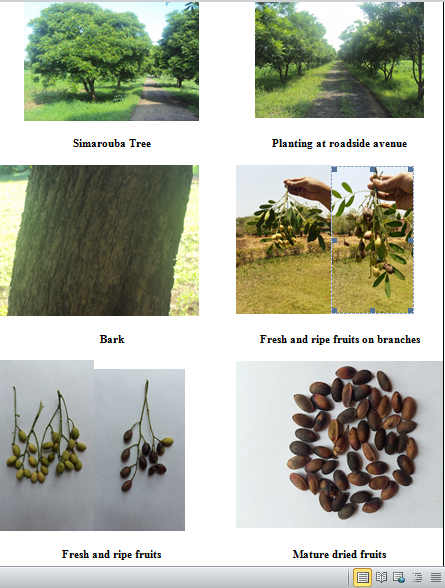Authors: Dinesh Chand, Smita Shingane, Sunil Gomashe and Nilamani Dikshit
Simarouba glauca DC (Family:Simaroubaceae) commonly known as Aceituno, Simarouba or tree of heaven, Paradise tree and is native of South or Central America. In India it is well known as Lakshmitaru. Lakshmi means “Goddess of wealth” and Taru means tree. It is a medium sized evergreen tree usually attains a height of 7-15 m. It has tap root system with warty cylindrical stem. The alternate imparipinnate compound leaves have 13-23 shiny glaucous leaflets. The plants are polygamodioecious with about 5% of the population producing exclusively male flowers (staminate) and 40-50% producing mainly male flowers and few bisexual flowers (andromonoecious), the remaining 40-50% producing only the female flowers (pistilate). Inflorescence is a panicle with ultimate branches bearing dichasial cymes. The plants are protandrous, flowering is annual beginning in December and continuing up to the following February. The trees start bearing when they are 4-6 years old (grafts begin to do so in 3-4 years) and attain stability in production after another 4-5 years. The druplets (blackish-purple in pink genotypes and greenish-yellow in green genotypes) are ready for harvest by April-May.
This is a potential oilseed tree with wide scope for bio diesel production. It is a multipurpose tree, which can grow in eroded soils with undulating topography and scarcity of bio resources. Simarouba can adapt to very dynamic climatic and edaphic conditions. It can grow well in range of soils from sandy, lateritic, to black vertisols with pH range of 5 to 8.5. This makes it a better choice for reclamation of degraded drylands.
It is very hardy tree and can with stand temperature up to 45 oC and can be grown at altitudes of up to 1000 msl. The seeds contain about 60-75% edible oil that can be used for the production of vanaspathi and/or margarine. The oil extracted from seeds is edible and also used in the manufacture of soaps, lubricants, paints, cosmetics, pharmaceuticals, polishes etc. (Joshi and Hiremath, 2000). After extraction the remaining nitrogen rich oil cake is a very good organic manure. Pressed cake contains high protein of about 64% which can used as a cattle feed after removing any toxic compounds from it. The shells can be utilized in cardboard/particle board making and activated charcoal. The ash remaining after utilization/burning contains high amount of potash. The fresh pulp from simrouba seeds contains about 11-12% sugars which can be used for making juice (about 12000 litres per hectare) or for fermentation in distilleries. This can be also used to produce a health drink or for production ethanol.
The leaf and bark have medicinal value which contains a chemical compound quassin, which is considered to be helpful in treatment of amoebiasis, diarrhoea and malaria. It has properties as haemostatic, anthelminthic, antiparasitic, antidysentric, antipyretic and anticancerous. Fruit pulp and seeds are possessing medicinal properties such as analgesic, antimicrobial, antiviral, astringent and stomachic tonic.
Leaf litter is a substrate for growing earthworms for making vermin-compost. The wood is generally insect resistant and is used for manufacturing light weight furniture, toys, paper pulp etc. Timber from this tree is light, moderately strong, attractively grained and can be used to manufacture household furniture and other products. It can be harvested by as early as six years. Products made from Simarouba resemble rubberwood products except the disadvantage of bending/distortion seen in rubberwood.

Disclaimer: The information given in the above article regarding various uses of simarouba tree is merely a compilation of information from various research articles, web pages and books available online. Authors are not responsible for the medicinal or any other use reported here.
References:
Joshi S and Hiremath S. 2000. Simarouba - A potential oilseed tree, Current Science. 78: 694-697
About Author / Additional Info:
Working as a Senior Scientist (Economic Botany & PGR)